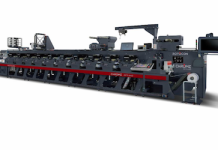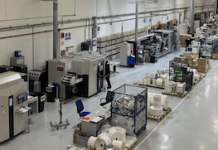Not one label is the same, different applications require different digital technologies, which is precisely why printing is such an exciting business. Whether it is for pharma, wine and spirits, beer, durables, health and beauty, industrial chemicals or beverages, every label comes with its own aesthetic and functional requirements. This article appears in the Africa Print Journal.
Wine And Spirits Labels
These are often printed on challenging materials (natural papers) and include high-end embellishments. Technically, these labels are among the most challenging for any label converter.
A Technology Agnostic Approach
At Xeikon, we did an in-depth analysis of different digital label printing technologies (dry toner and liquid toner electrophotography, UV-curable inkjet and water-based inkjet), taking into account quality basics (dot positioning and dot sizes), substrate compatibility and process reliability as well as characteristics such as look and feel, durability and sustainability.
Specifically for wine and spirit labels, it is important to realise these require a digital printing technology that is capable of delivering high quality labels on a wide range of challenging substrates that absorb liquid inks. Therefore Xeikon recommends its dry toner printing processes over water-based, UV inkjet or even liquid toner. Why? Because dry toner excels in three key areas that are important for wine and spirit label converters.
1. Wine And Spirits Substrates
A broad range of substrates is used in wine and spirits, from synthetic, coated paper to the most challenging natural, structured papers. The last one, a very porous material, can only be printed on properly with dry toner as it doesn’t require any pre-conditioning or primer prior to printing. Any liquid ink is absorbed by the facestock and, as a result, will degrade in colour strength. Incidentally, applying a primer is always difficult as the layer gets partly absorbed by the paper. Dry toner, on the other hand, sits on top of the paper, is not absorbed and keeps its colour strength.
2. Embellishment Modules
Spot varnish and foiling are common processes for wine and spirits labels and make them really stand out. Due to the absence of solvents, fuser oils or other liquids, dry toner is compatible with any kind of process (spot varnish, cold foil and hotfoil). Moreover, embellishments can be handled digitally too, using Xeikon’s Fusion technology, a unique solution of digital combination printing. It combines full colour digital production printing with digital embellishment of labels and packaging in a single, one-pass and fully digital production process.
A print job is dropped in a hotfolder, RIP’ed and the different channels are sent to the relevant Fusion modules, including the press, without further manual intervention. Because every embellishment module is digital, every single design element in the design can be made variable or personalised, which opens up huge opportunities for new applications.
3. High Image Quality
Wine and spirits frequently boast fine details, making image quality crucial. The dry toner printing process has a print resolution of 1200dpi, where several particles create one image dot and where the toner is transferred to the exact position over and over, very consistently. With water-based or UV inkjet, one drop creates the actual image and any variation to the position and size has immediate effect on the quality.
Beer And Beverage Label Printing
These labels require a specific approach to get the desired white opacity level and look and feel of the end product. The no-label look, a capability provided by clear-on-clear label materials, has transformed beer labels into a strong growth market for the self adhesive label market, at the expense of wet-glue labels.
The growth of clear-on-clear adhesive labels is driven by the fact that they provide more capabilities regarding aesthetics, such as variation in look and feel.
Which Beverage Label Type Do You Produce?
Beverage labels can be divided in two types. There are the craft beer labels, which are paper-based labels, with natural or coated paper facestock and commonly printed in four-colour. The other type is premium labels, for which clear-on-clear materials and BoPP facestock are typical and high white opacity is a requirement to make the colour stand out.
Regardless of the type, Xeikon recommends both dry toner and UV inkjet printing technology. So how do you know which technology is best suited for a specific beverage label project? This choice depends on a number of factors.
Substrates
Two factors determine if a printing technology is suitable for a certain substrate: adhesion (if and how well the printed image stays fixed to the substrate) and pigment penetration (if and how well the ink or toner penetrates the substrate). For beverage labels, adhesion should be high in different conditions (in a refrigerator, outdoor, in an ice bucket, etc.), while pigment penetration should be avoided at all costs as this reduces colour strength and implodes the colour gamut.
The two common substrates consist of paper or BoPP facestock. Due to its chemical affinity, dry toner is a great choice for both paper and BoPP facestock. It can be used without any coating or primer and still achieve good adhesion and no pigment penetration. UV-curable inkjet, due to its low viscosity (six times lower than UV flexo), can penetrate paper so a primer is recommended. This will improve the UV curing process and ensure proper image quality. For BoPP facestock you need to ensure a high enough surface tension to achieve a proper spread of the UV inkjet ink.
White Opacity
For premium beverage labels (clear-on-clear labels), a sufficient level of white opacity is required. The opacity of white is determined by the concentration of pigments, pigment particle size and the layer thickness that can be achieved. Dry toner scores well on both accounts as the technology allows for thick toner layers. White dry toner combines the highest pigment load with the largest particle size, offering white layers of an opacity that is higher than that of liquid toner, in a single pass.
For UV-curable inks used in single-pass inkjet systems, the pigment particle size should be small enough to avoid nozzle clogging. Also, the required viscosity of the inks does limit the maximum possible pigment load. However, inkjet inks are capable of achieving an opacity comparable to that of screen printing, provided the print head features a low native resolution, producing a large-sized droplet, which allows for high ink lay-down.
Look And Feel
Dry toner gives a matte impression which, by applying a varnish, can give a glossy impression. When offset quality is required, this technology is preferable. UV inkjet gives a very high gloss and tactile impression, which can appeal to certain people. The image details are not as sharp as dry toner but this is not necessarily a requirement (‘beauty is in the eye of the beholder’). The appearance of both technologies is not influenced when the labels get in touch with the water (condense) on the outside of the bottle.
Food Label Printing
These labels have specific requirements due to their stringent food safety regulations and demand for high quality at reasonable cost.
Food Safe Digital Label Printing And The Concept Of Migration
A crucial concept in the discussion of food safety is 'migration' – the transfer of substances from the packaging to the packed foods. In order to measure the likeliness of substances migrating through packaging and thus contaminating the food, migration thresholds are defined. The so-called Specific Migration Limit (SML) is the maximum permitted amount of a given substance that can be released from a packaging material or printed layer into food.
Here Are Some Of The Most Important Factors Contributing To Migration:
• Size of the ink/toner molecule: the larger the molecule, the less its tendency to migrate temperature: migration is faster at higher temperatures.
• Nature of the food: fatty foods are more prone to migration then dry foods.
• Nature of the packaging materials.
• Type of coating.
Food Safety And Dry Toner
When it comes to food safety, dry toner clearly has an advantage over other technologies, such as liquid toner and inkjet, both in terms of migration and chemical composition. For example, the colourant used to produce dry toner is a pigment, which isn’t considered a migrant. There is no liquid substance involved and surrounding the pigment particles is a polyester resin, which is a polymer with a high molecular mass, also highly unlikely to migrate.
Liquid toner is less suited for food label printing as it requires a carrier liquid. Usually a mineral oil is used, which evaporates during and after the electrophotographic process. However, if the residual carrier liquid isn’t allowed enough time, some particles may still be present.
Inkjet Food Label Printing And Cost
Water-based inkjet consists mainly of pigments that have no tendency to migrate and neither have the dispersing agents – very high molecular weight compounds. The only potential migrants present in water-based inkjet prints are humectants residing in the substrate prior to full evaporation. However, water-based inkjet is rarely used since adhesion to polymeric substrates is problematic.
UV curable inkjet is prone to penetrate paper substrates due to its low viscosity (six times lower than UV flexo). The low viscosity is required to ensure that the ink can be jetted through the small inkjet nozzles so this is an intrinsic issue of the technology. When the ink penetrates the substrate you cannot properly cure the ink, leaving dangerous components exposed to migrate. This is a risk you simply cannot take.
A primer can reduce the penetration problem but not overcome it. Anyhow, a primer is required when printing on paper based materials to achieve good solids and proper colour gamut. However, this increases the cost. Dry toner, on the other hand, can print on standard paper label materials without any primer, making it the best choice for food label printing.





















